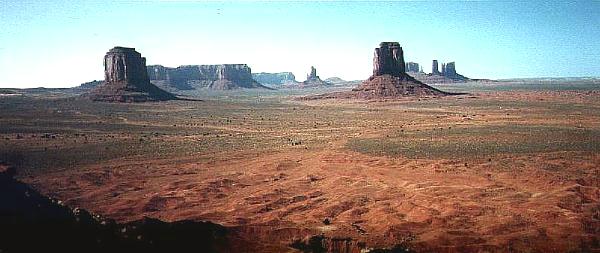
Ecological interactions
Graphics
One way to view interactions is w/ a matrix: [+,0,- matrix]
| | + | 0 | - |
| + | ++ | +0 | +- |
| 0 | 0+ | 00 | 0- |
| - | -+ | -0 | -- |
| --
competition |
| 0-
amensalism |
| +-
"contramensalism" (recently coined); includes predation,
parasitism, herbivory |
| +0
commensalism |
| ++ mutualism
(symbiosis) |
- As w/ any classification system, reality is more complex than the
model (i.e., classification system)
- Therefore, the category assigned to an interaction should be
placed in context--understanding the "nature" of the
interaction is more important than properly classifying
it
- The temporal and spatial scales used to view the interactions
affect what you perceive the interaction to be
- Reasons to avoid "+" and "-":
- Ecological vs. evolutionary effects
- ecological effects (usu. rel. short time scales) are
measured by changes in abundance (number or size of
individuals)
- "success", from an evolutionary perspective, is
evaluated by presence or absence
- evolutionary effects (usu. rel. long time scales), acc.
to some authors, indicate the "importance" of
competition, whereas ecological effects indicate the
intensity of competition
- Another reason to avoid "+,-" terminology:
- Herbivory may or may not be detrimental, even at the level
of the individual plant
- herbivory increases reproductive output of some plants
[Paige and Whitham 1987 Am. Nat. 129:407-416]
- response of plants to herbivory is strongly dependent
on size of plants and time of year
- Thus herbivory may be +- for some species or
individuals within a species, but may be +0 or ++
for others (assuming herbivory is always
beneficial for herbivores)
- this brings up the question of how to evaluate
detrimental impacts to plants
- Population:
- intuitively palatable:
- we can address mortality and recruitment,
thus measuring these changes "integrates"
over many generations
- but is this where results of interactions are
"felt"?
- interactions directly affect individual
plants
- Individuals:
- interactions affect individuals, and
individuals are the agents of natural
selection
- what characteristic(s) should be evaluated--
Ps rate, growth rate (total, aboveground,
belowground)?
- One of the impediments to progress in research on
interactions is the incomparability of many
(most?) studies--to a large extent, individual
researchers measure whatever is convenient (for
them) to measure
- convenience = f(available equipment, time,
personal interest), usu. w/ little or no
thought to what is most appropriate
More
graphics
- Any study of a pop'n or community should consider resources--they
will virtually always play a role in organizing communities
- other factors, such as weather, predation, or herbivory may
be important
Kind of resources
Resource (Tilman 1982): any substance or factor which is
consumed by an organism and which can
lead to increased growth rates as its
availability in the environment is
increased
There are only a few basic elements which are resources for
living organisms [Keddy 1989 Table 1.1, p. 4]
Various classification systems have been developed for resources:
- Trophic position
- Consumers of resources are commonly classified by trophic
position--autotrophs vs. heterotrophs
- Problems w/ using trophic position to classify organisms:
- many animals change trophic level w/ changes in age,
season, or climate
- The chemical composition of organisms is remarkably
constant, which makes the distinction between autotrophs and
heterotrophs seem particularly arbitrary
- Temporal and spatial distribution
- Types of resources, based on how they vary w/ time:
[Keddy 1989 Fig. 1.1, p. 6]
- Increasing: gradually increases over the active
season of an organism, then suddenly
declines
- Decreasing: produced suddenly at the beginning of a
season, then gradually declines
- Pulsing (ephemeral): increase & decline rapidly
- Steadily renewed: continuously renewed over long
periods
- More elaborate classification systems incorporate spatial
variation (not just temporal variation) in resource
availability [e.g., Keddy 1989 Fig. 1.2, p. 8]
- Mode of consumption
- "Consumptive" competition: organisms harvest a fraction
of a resource over a large
area
- "Space" competition: organisms harvest all of a resource
from a fraction of the area
- Resource ratios [ref. Tilman 1985 Am. Nat. 125:827-852;
economic parallels illustrated by Trepl
1994 Ecol. Modelling 75/76:71-82]
- Organisms usu. must forage for more than 1 resource -->
Tilman's ideas about resource ratios
- Essential resources can not be substituted for each
other, whereas
- Substitutable resources can be interchanged, to varying
degrees
- Growth isoclines indicate resource type [Keddy 1989
Fig. 1.3, p. 10]:
- solid lines are zero growth isoclines, shaded
areas indicate regions of negative growth
- Substitutable resources can be further classified,
based on degree of substitution:
- perfectly substitutable resources
- complementary resources--have a synergistic
effect, so that combinations produce more growth
than equivalent amounts of either resource alone
- antagonistic resources--interfere w/ each other
when consumed, so that a mixture of the 2 reduces
growth relative to either resource by itself
Previous
lectureNext
lecture
